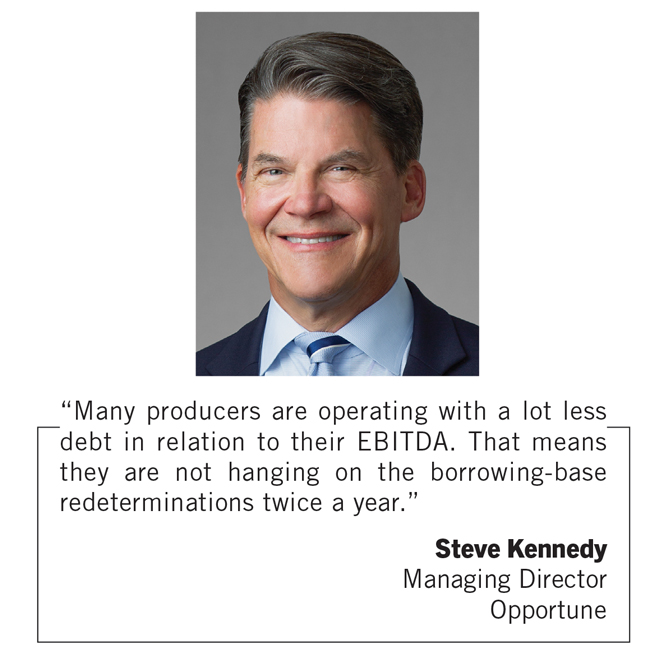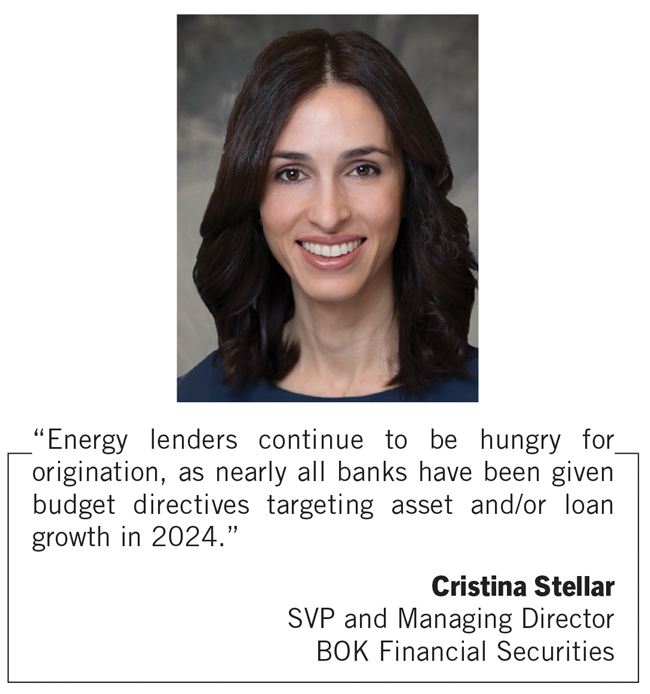
RBL Loans Bounce Back, Price Decks Inch Higher
By Gregory DL Morris
Like many other aspects of oil and gas finance, reserve-based loans have evolved as the industry has strengthened its focus on capital discipline and healthy balance sheets. Banks and the producers they serve have reevaluated leverage levels to ensure that both groups can navigate periods of volatility. Today’s more modest RBLs still give operators welcome liquidity to move quickly on acquisition opportunities.
Many lenders appreciate the loans because they often lead to other business, says Steve Kennedy, who spent 36 years as an energy banker before becoming a managing director at the consultancy Opportune last year. “Every bank will tell you that it wants a full relationship. That could be deposits, or treasury or banking the company executives on a personal level. Banks all have different approaches, but none of them want a ‘dry’ loan, with no ancillary business,” he says.
RBL’s potential to support other services may explain why some banks are entering the space, Kennedy muses. “Eight years ago, there were about 30 banks that would have a price deck for hydrocarbons. That did not necessary mean they were actually making loans, but they at least had their shingle out,” he relates. “That number fell to about a dozen at the low point. Now, it’s bounced back to about 20 banks that are making secured loans. There are a few others, maybe 10, that are making unsecured loans, but only to investment-grade companies.”
For the most part, banks active in RBL have between 2% and 5% of their total loan portfolios in that segment, Kennedy estimates. In years gone by, it was not unknown for a bank to have as much as 10% of its total loan portfolio in RBL, but that level now seems imprudent to lenders and unnecessary to operators.
“Many producers are operating with a lot less debt in relation to their earnings before interest, taxes, depreciation and amortization,” Kennedy notes. “That means they are not hanging on the borrowing-base redeterminations twice a year.”
Most public independents used to have enterprise values of 6.0x-8.0x their EBITDA, Kennedy recalls. “Many banks would be happy to lend at half that level, so 3.5x debt to EBITDA, with a covenant limit of 4.0x. That is for companies with an enterprise value below $3 billion.
“Today, those same companies trade at 3.5x to 4.5x EBITDA,” he contrasts. “These numbers require a lower covenant limit, which is currently being set at 3.0x, but banks are not actually comfortable with borrowers close to that. Instead, the preferred limit is closer to 2.0x–and in practice, the ratio must be below 2.0x to enable the borrower to make cash distributions.”
The focus on cash flow is a testament to investors’ power. “There is not a lot of argument about those levels from industry,” Kennedy remarks. “Investors have put cash-distribution discipline on industry, so now, we usually see debt-to-EBIDTA ratios of 1.50x-1.75x.”
Implications for A&D
The emphasis on financial discipline encourages companies to make acquisitions without taking on much debt, Kennedy observes. He suggests that this may slow post-acquisition divestitures, as acquirers can hold on to noncore assets rather than urgently marketing them to reduce debt.
There are many ways for producers to manage capital, but second liens are much less common than they were only a few years ago, Kennedy reports. “Reserve-based lenders generally dislike second liens, because they have lost real money to second liens in previous down cycles,” he says.
Such losses occur even though second liens are subordinate. “In a bankruptcy, the second lien can hold the first lien hostage by threatening to cause trouble,” Kennedy explains. “There have been situations where the second lien gets paid 5%-10% even when the first lien was at a loss.”
Even when there is no bankruptcy, Kennedy continues, second liens can increase the amount of capital a lender has to hold. “Since 2016, the Office of the Controller of the Currency has specified how all secured debt, first and second, is graded. If the first lien is well covered, but the second is not, they are both downgraded, forcing the bank to hold more capital against a loss,” he clarifies. “That is true even if the lender of the first lien does not hold the second.”
It also is unusual for other forms of debt to be combined with RBL. “In many cases, asset-backed securities (ABS) act as a replacement for RBL,” Kennedy allows. “An exception is when ABS provides debt for special-purpose entities that are subsidiaries of a parent company, and the parent has separate assets pledged under an RBL.”
As lenders have gotten more experience with unconventional plays, Kennedy says they have become more conservative. “Initially, producers and debt engineers severely overestimated unconventional wells’ production because they did not yet understand interference between wells and how horizontal fracs degrade over time,” Kennedy says. “It took a while to appreciate those effects and begin accounting for them.”
Eager Lenders
While banks are taking a more conservative approach to structuring RBLs than they once were, they are seeking opportunities to lend, says Cristina Stellar, senior vice president and managing director of BOK Financial Securities.
“Energy lenders continue to be hungry for origination, as nearly all banks have been given budget directives targeting asset and/or loan growth in 2024,” she reports. “Growth has been difficult for lenders to achieve because of continued portfolio attrition associated with consolidation in the sector. 2023 was a record year for corporate consolidation.”
This trend, along with moderation of drilling budgets, has contributed to relatively low loan volumes. In fact, LSEG Refinitiv’s upstream issuance data through the second quarter of this year, the latest period for which data is available, puts loan volume at its lowest level since 2020.
“We are starting to see rationalization transpiring in the market with more deals,” says Stellar. “As consolidators’ noncore assets continue to hit the market, the expectation is to have a fairly active fourth quarter of 2024 and first quarter of 2025. In the past, the last quarter of the year has been a challenging time for lenders to raise new capital on the bank debt side.”
The competition for deals that comes from historically low volume has driven loan pricing for well-capitalized borrowers downward by 25 basis points (bps) across grids, Stellar mentions. “Most deals are coming to market at 275-375 bps as compared with 300-400 bps, which we have seen consistently since Covid,” she details. “Higher deal activity in the fourth quarter may drive higher loan values.”
Price Considerations
With a few exceptions, oil prices for the past couple years have supported dealmaking by staying range-bound between $70 and $80. While Stellar cautions that global geopolitics can lead to extreme price volatility, she says that possibility has not affected deal flow yet. “Deals are transacting. We are seeing that in our shop and in recent announcements,” she shares.
It likely helps that many lenders anticipate higher prices for natural gas. “The increase in takeaway capacity is a bullish trend for the second half of 2025,” Stellar says. “LNG exports, increasing power demand from data centers, widescale electrification to meet net-zero carbon goals, and industrial-related power demand for manufacturing, from steel to new chip factories, should support gas prices in the future.”
Another bullish trend Stellar references is Europe’s “shift in mentality and the realization that new energies complement—rather than replace—traditional energy, and that net-zero can’t happen without oil and gas.” She says, “We are seeing a general slowdown in the push for alternative energy in favor of natural gas.”
In early 2025, gas prices should top out at $3 given excess supply, Stellar predicts. “Of course, if we have a cold winter, we could see prices rally. And Russia’s gas supply to Europe during the winter months is a wild card,” she says.
Generally, crude prices tend to dip at the end of the driving season, a pattern that has held so far this year, Stellar observes. “We expect lower prices for the remainder of 2024,” she says. “OPEC should provide a floor, with the possibly of further cuts if WTI prices remain below $70. Prices have softened earlier, but this is something we saw in the fourth quarter of 2022 and 2023.”
For crude, Stellar says India may be the wild card. “The country has been taking a lot of supply, and as it comes out of maintenance season, it could support prices toward the end of the year and into 2025,” she suggests.
Rig activity no longer matters as much as it used to. “In the past, we saw a correlation between rig count and WTI with a lag time of about three-six months,” Stellar describes. “That trend changed starting in December 2022, when rigs continued to decrease as prices stabilized. The drivers for that shift are capital discipline, consolidation, drilling and completion efficiencies, and low gas prices.”
Regarding capital discipline, Stellar says the data is clear. “For public exploration and production companies, capital expenditures from 2023 to 2024 are anticipated to increase an average of 2%,” she illustrates.
Price Survey
Like Stellar, the Haynes Boone Spring 2024 Energy Bank Price Deck Survey highlights some bankers’ expectation that natural gas prices will go up. “Spurred by full inventories and one of the hottest winters on record, natural gas prices fell to a 30-year low of less than $1.75/MMBTU in March 2024,” the firm acknowledges. “Yet the spring 2024 gas base-case data anticipates prices returning to the $3.00/MMBtu mark by 2025.
“The restoration in pricing may be at least partially attributable to industry prognostications on the near-term ascent of artificial intelligence and its massive electricity and data center demands,” Haynes Boone assesses. “The spring 2024 gas base-case pricing data also shows a slight, but generalized, decrease in gas price expectations from 2026 to 2033 of $0.13-$0.19/MMBtu relative to the fall data.”
The spring survey includes data from 26 energy banks. Most of the participants are regional banks that target smaller loans to independent oil and gas producers, but Haynes Boone notes the survey also includes data from national banks that lend to larger producers.
The survey finds that many banks’ price decks forecast lower oil prices. “For oil prices, the base case trend line for the spring 2024 data remains on a similar path as the fall 2023 data, in which there was an incremental decline in oil prices expected until 2027, when projected prices stabilized in the $55- $60/bbl range through 2033,” Haynes Boone clarifies. “In the spring 2024 results, there was, however, a slight increase in expected oil prices during the 2029-2033 period that may be attributable to the recent confidence in the upstream business exemplified by the historical spree of consolidations among exploration and production companies over the last year.”
Individual banks’ predictions vary widely. “In all scenarios for oil and gas, there is notable deviation in banks’ price projections,” the firm comments. “Though most banks anticipate a general decline in oil and gas prices beyond 2025, several banks still project growth in oil and gas prices into the 2030s. This optimism may be fueled by major oil and gas companies’ recent reemphasis on investing in hydrocarbon exploration and production in their short- and long-term strategic plans.”
Industry Resilience
Thanks to capital discipline, the upstream industry has gotten better at weathering downturns, suggests Spencer Cutter, senior credit analyst with research and consulting firm Bloomberg Intelligence. “During the last down cycle, borrowing base determinations were not so bad because no one was on the edge of liquidity,” he says. “That is different from the previous cycle in 2015-16, when a few companies did hit the wall. But banks were just protecting themselves.”
RBL is “as much of an art as it is a science,” Spencer considers. “It’s not pure math. There is a lot of wiggle room to cut, hold or expand the borrowing base. I was in investment banking for many years, and we would lend to get our foot in the door for mergers and acquisitions, bond placements and underwriting. In many cases, the lender’s actual commitment is less than the borrowing base, and they can evaluate that commitment with a broader relationship in mind.”
That relationship may include hedging if the bank has a large commodity trading group, Cutter adds. “If there is more to be made on the borrowing base, the RBL itself could be attractive to regional banks. But the bigger banks make the revolver available because they want to be the book runner or leader on an M&A transaction,” he summarizes.
The process for determining borrowing bases resembles the one for calculating PV-10 in the sense that it looks at expected free cash flow from the reserves after accounting for drilling costs, production, realized commodity prices and other factors, Spencer says. However, the details for evaluating those factors differ. As an example, borrowing base calculations use forward-looking price curves rather than backward ones. Spencer adds that borrowing bases tend to be much smaller than PV-10, as they focus on proved developed reserves and give far less weight to undeveloped, probable and possible reserves.
Vincent G. Piazza, a senior oil and gas equity analyst for Bloomberg Intelligence, comments that producers’ balance sheets have been clean. “Net debt to EBITDA has been close to 1x, a level indicating a healthy industry that can throw off some cash,” he says. “There has not been a need to tap equity markets aside from M&A. We have seen that for consolidations, but deals are often constructed with cash and stock.”
Piazza tracks 30 companies in the upstream sector, ranging from Occidental and Conoco to SM Energy. He mentions that several recent deals involve private sellers.
“Private equity needs to recycle its capital,” Piazza says. “There are some vintage funds that need to find a home for their sponsorships, so we are seeing PE assets being purchased by public companies that want to increase free cash flow. They use that cash to buy back stock, then use the stock to purchase other assets.”
Private Investors
Mark Miller, president of Merlin Energy Inc. in Lafayette, La., and chairman of the Independent Petroleum Association of America from 2015 to 2017, stresses that all types of capital are important to upstream independents. “Capital is available, both debt and equity,” he assures. “There are private companies looking to be involved in one or two projects, and others with the resources to be involved in 30 or 40 projects.”
Although RBL has become a smaller piece of the capital puzzle, it remains an important one for producers, Miller says. Among many other functions, an RBL can reassure private investors that a company’s assets have value. “This is especially important for investors who are coming into energy from other sectors, such as professional athletes or people who made their money in tech,” he says.
To illustrate how much interest those investors have in energy, Miller recalls holding a dinner to connect industry experts with long-time investors and new faces. “I put the best explorationists and producers together with land owners and investors in one room,” Miller describes. “There was no agenda except to get to know each other and learn from each other. I can tell you, the room was buzzing.
“There is generational wealth in this industry that has been good for many families,” Miller says. “At the same time, there are a few second and third generations that are just getting back to the industry. What matters is that there is capital available through both debt and equity, and people who want to use that capital to develop oil and gas responsibly.”
For other great articles about exploration, drilling, completions and production, subscribe to The American Oil & Gas Reporter and bookmark www.aogr.com.
















